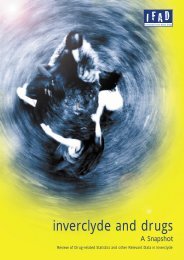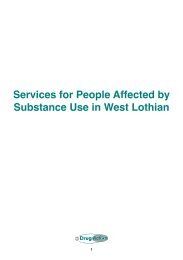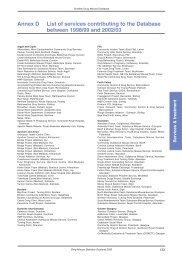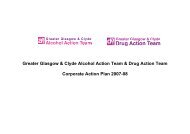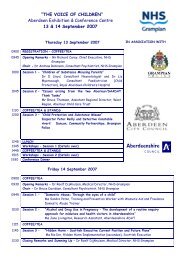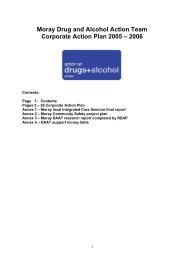3programmes were not sufficient to prevent HIV transmission, conceded that they had acrucial role to play (Strathdee, et al, 1997; Schechter, et al, 1999).Less research has been carried out to investigate the role of needle exchanges in reducingthe transmission of blood-borne viruses other than HIV. However, what evidence there issuggests that needle exchange programmes are also associated with reductions in HCV,HBV and subcutaneous abscesses (Harris, 1997). A study carried out in America reportedthat IDUs who used a needle exchange were between 6 and 11 times less likely tocontract HBV or HCV compared with IDUs who did not use a needle exchange (Hagan, etal, 1995). In another American study, they found that needle exchange programmes wereassociated with a m inimum of a 33% reduction in HBV incidence (Heimer, et al, 1996).Fina lly, resea rch ca rried o ut in Austra lia found a concurre nt de cline o f 50% in needlesharing behaviour and a decline from 22% to 13% in HCV prevalence among IDUs duringa 3 year period (MacDonald, et al, 2000).Critics of needle exchange programmes have argued that needle exchanges may increasethe use of illegal drugs and cause more widespread use. However, extensive research hasshown that this is not the case and that needle exchanges can actually reduce drug usethrough referrals to drug treatment and counselling (Watters, et al, 1994; Heimer &Lopes, 1994;Buning, 1991). Studies have also concluded that needle exchanges do notincrease inje ction frequency among IDUs, the numbe r o f initia tes to inje cting drug use o rmore widespread drug use (Normand et al, 1995; American Institute of Health, 1997).Moreover, needle exchange programmes do not increase the number of syringes discardedin public places (American Institute of Health, 1997). Indeed, some areas where needleexchanges have been introduced have reported a decrease in the number of discardedsyringes (Normand, et al, 1995; O liver, et al, 1992).Another argument often cited by critics of needle exchanges is that by giving IDUs accessto needles, they may be discouraged from entering drug treatment programmes. Again,extensive research has shown this claim to be untrue. Many IDUs who use needleexchanges ask for referrals to treatment (Heimer & Lopes, 1994, Hagan, et al, 1993,He imer, e t al, 1996). In Austra lia , resea rche rs found tha t intro ducing a needle ex cha ngenext to a methadone clinic did not reduce the number of admissions for treatment orresult in an increase in dropouts o r positive urine tests a t the metha done clinic (Wolk , e tal, 1990).In addition to these benefits, needle exchanges also make economical sense, with the costof running them far below the costs associated with treating or caring for IDUs with bloodborneviruses (Lurie, et al, 1993; Holtgrave & Pinkerton, 1997).In summary, there is now overwhelming scientific evidence to show that needle exchangeprogrammes reduce the spread of blood-borne viruses without increasing drug use or thenumber of discarded syringes. In fact, they can actually reduce drug m isuse by referringIDUs to treatment programmes. <strong>The</strong>y are also cost effective and serve to improve thelives of IDUs and their families.In a further bid to reduce the harm associated with injecting drug use, and in an attemptto increase the use of their services, some needle exchanges are now starting to offerIDUs additional injecting paraphernalia such as single use citric acid sachets.<strong>Provision</strong> of <strong>Single</strong> <strong>Use</strong> <strong>Citric</strong> <strong>Acid</strong> <strong>Sachets</strong><strong>The</strong> majority of IDUs who use needle exchanges in the UK are heroin injectors. Whileheroin in its purest form is highly water soluble, street heroin in the UK tends to be brown
4and is so ld in poo rly so luble base fo rm (King, 1997). In o rde r to make the he ro in baseso luble , a n a cid mus t be a dded to co nve rt it into a sa lt. <strong>Acid</strong>s tha t can be used tofacilitate solubility in this way include citric, ascorbic, acetic and lactic acids. IDUs havetended to use readily available forms of these acids such as commercial brands ofprocessed lemon juice, fresh lemon juice, vinegar and other household products. Althoughthese products are used to promote solubility and thereby reduce the risk of harm causedby injecting particles, they are in fact often a source of harm themselves.Lemon juice both in its packaged and fresh forms can carry fungal infections, which, wheninjected, can infect the heart (endocarditis) and cause candidal endopthalmitis, aninfection of the eyes that can lead to blindness (Gallo, et al, 1985). At a recent conferenceof needle exchange workers in the UK, there was a noted increase in reports of blindnessamong IDUs. <strong>The</strong>se were attributed to candidal endopthalmitis caused by using lemonjuice to a cidify he ro in prio r to inje ction (P reston & De rrico tt, 2001).<strong>The</strong> re is lim ited e vidence tha t using vinega r to disso lve he ro in is ha rm ful. Ho we ve r, aswith lemon juice, be ca use vinega r is a liquid it is conce ivable tha t it could e ncourage thegrowth of bacteria or fungal infections such as candidal endopthalmitis (Lazzarin, et al,1985).Asco rbic a cid (vitam in C ) can also be use d fo r the prepa ra tion of he ro in fo r inje ction.Some have argued that it might be safer than citric acid because it allows a greatermargin of error: ascorbic acid is less acidic than citric acid and a small increase in theamount used is unlikely to cause vein damage or burn the user. In practice, however,IDUs learn from experience and their peers how much acid to use and persistent over useof citric acid seems to be rare (Preston & Derricott, 2002). Moreover, it is now beingsuggested tha t if a sco rbic a cid is inje cted in la rge doses, a s o ccurs in ce rta in medica lco nditio ns, it could lead to the fo rmatio n o f k idney stone s (P resto n & De rrico tt, 2002). It isunlikely that the amount of ascorbic acid injected by IDUs would be large enough to causesuch physical problems, but it nevertheless remains a possibility.C itric a cid is be lie ved to be the sa fest a cidifie r to use fo r the prepa ra tio n o f bro wn he roinfo r inje ction, a s it is readily a va ila ble in pure fo rm , is o f co nsistent strength a nd complieswith the British Pharmacopoeia (BP) standard (Preston & Derricott, 2002). However,supplying citric acid to IDUs remains, in principle at least, illegal by virtue of Section 9A ofthe Misuse of Drugs Act 1971. However, there have been recent calls for a repeal of thislaw, and to date no one has ever been prosecuted for supplying citric (or ascorbic) acid.This is be cause pro se cution fo r ha rm reduction initia tives wo uld no t be in the publicinterest. Despite this, some pharmacists’ concerns about the, albeit very low, risks ofprose cution had, until re cently, made them re luctant to supply it. This had made it ve rydifficult for IDUs to obtain citric acid and had resulted in their use of more dangerousa cidifie rs.Acting on behalf of the Greater Glasgow Drug Action Team (DAT), and in a bid to reduceconcerns and reassure pharmacists, the Regional Procurator Fiscal (RPF) approached theLord Advocate’s department about the supply of citric acid sachets to IDUs. <strong>The</strong>y wereadvised that under no circumstances would pharmacists supplying citric acid as part of anapproved needle exchange programme be prosecuted. <strong>The</strong> three RPFs responsible forGreater Glasgow NHS Board and Lanarkshire NHS Board areas also provided “letters ofcom fo rt” which we re fo rwa rded to a ll pha rma cis ts to furthe r reas sure them. <strong>The</strong> re thenfollo we d a sho rt pilo t study o f supplying IDUs a ttending nee dle ex changes with 200mgsachets of citric acid. This trial highlighted that while IDUs liked the idea of single usesachets, 200mg was excessive in terms of the amount of citric needed for each injection.I ndeed, 100mg of citric a cid was found to be mo re than sufficient to disso lve the £20worth of heroin usually injected. 100mg is also the smallest amount of citric that can befea sibly pa ckage d in single sa che ts and is the refo re the sa fest o ptio n po ssible. As a result



